Europe tests primary support
By Colin Twiggs
August 9th, 2014 10:30 a.m. AEST (8:30 p:m EDT)
Advice herein is provided for the general information of readers and does not have regard to any particular person's investment objectives, financial situation or needs. Accordingly, no reader should act on the basis of any information contained herein without first having consulted a suitably qualified financial advisor.
Research & Investment: Performance update
ASX200 Prime Momentum strategy returned +20.35%* for the 12 months ended 31st July 2014, outperforming the benchmark ASX200 Accumulation Index by +3.81%.

Returns for July 2014 were 4.67%, so why the decline in rolling 12-month performance? Because performance for July 2013 (11.00%) is now excluded from the last 12 months. Another exceptional month was February 2014 (9.04%). Momentum performance tends to concentrate in a few good months each year which is why we are so averse to timing secondary corrections — if you miss one good month, it will hurt your annual performance.
The S&P 500 Prime Momentum strategy has been running nine months, since November 2013, and returned 8.92%* for the period, compared to 11.63% for the S&P 500 Total Return Index. A sell-off of momentum stocks affected performance since April, but macroeconomic and volatility filters indicate low risk typical of a bull market and we maintain full exposure to equities.
* Results are unaudited and subject to revision.
Europe tests support
Summary:
- Europe threatens reversal to a down-trend.
- S&P 500 finds support.
- VIX continues to indicate a bull market.
- China's Shanghai Composite encounters selling pressure.
- ASX 200 experiences a secondary correction.
Dow Jones Europe Index is testing the primary trendline and support at 315. 13-Week Twiggs Momentum below zero already warns of a primary down-trend. Breach of primary support at 315 would confirm. Respect of primary support and recovery above 330, however, would suggest that the primary trend is intact.
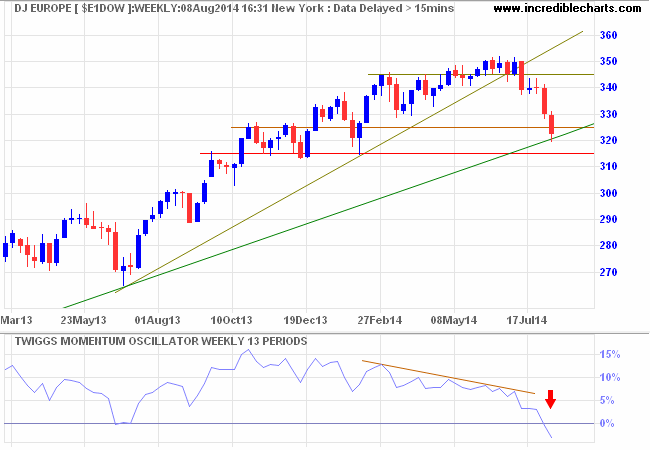
Germany's DAX continues to test primary support at 9000. A long tail on Friday suggests short-term support. Failure of support would warn of a decline to 8000*, while respect would suggest another test of 10000.
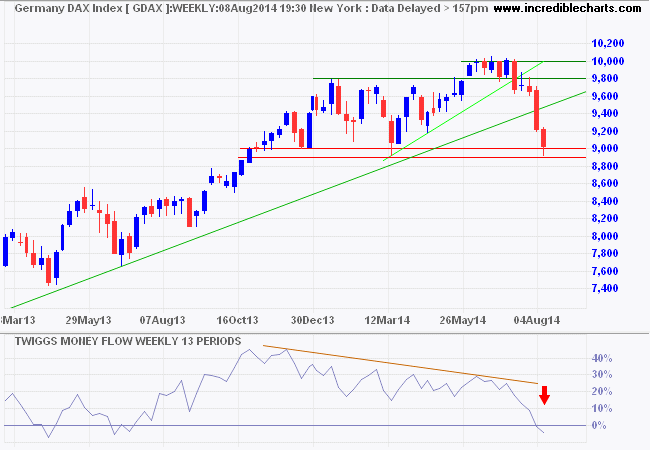
* Target calculation: 9000 - ( 10000 - 9000 ) = 8000
The S&P 500 found support at 1900 and recovery above 1950 would indicate another advance. The latest decline on 13-week Twiggs Money Flow is relatively small and recovery above its July high would suggest that buyers have taken control. Failure of 1900, however, would warn that the primary trend is slowing.
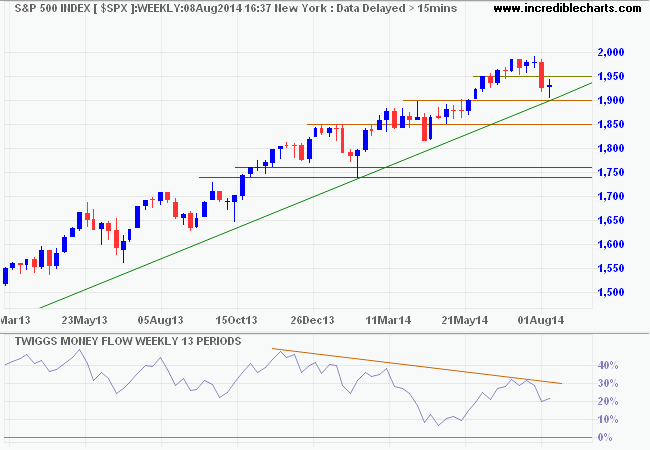
* Target calculation: 1500 + ( 1500 - 750 ) = 2250
CBOE Volatility Index (VIX) spiked upwards, to between 16 and 17, but remains low by historical standards and continues to suggest a bull market.
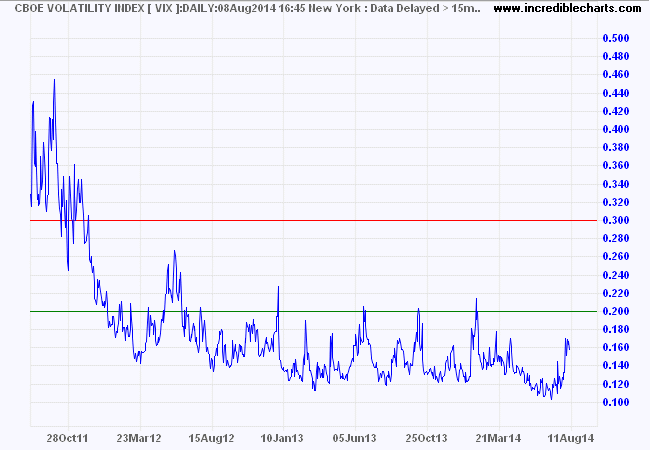
China's Shanghai Composite Index encountered selling pressure below resistance at 2250, with tall wicks/shadows on the last two weekly candles and a sharp fall in 13-week Twiggs Money Flow. Reversal below 2150 would warn of another test of primary support at 1990/2000. Follow-through above 2250, however, would confirm a primary up-trend.
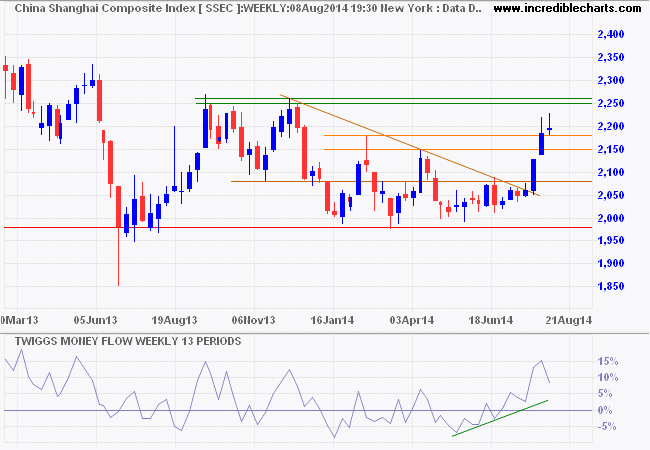
* Target calculation: 2000 - ( 2150 - 2000 ) = 1850
The ASX 200 is heading for a test of support at 5350/5400 and the primary trendline. Direction will largely be influenced by the US and Chinese markets, but reversal of 13-week Twiggs Money Flow below zero — after long-term bearish divergence — would warn of strong selling pressure. Recovery above 5550 is unlikely at present, but would suggest another advance. Reversal below 5050 is also unlikely, but would signal a trend change.
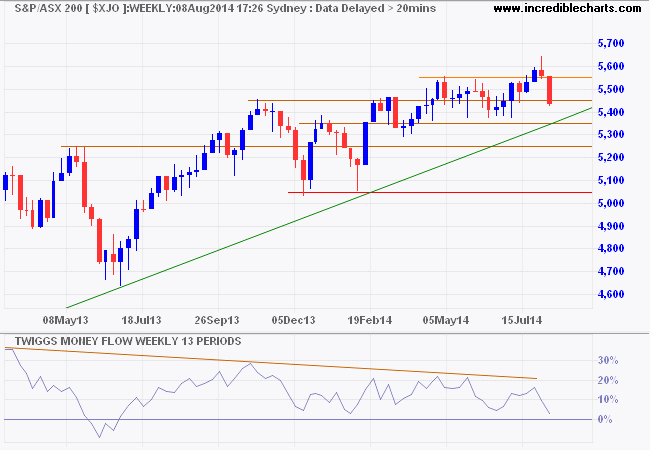
* Target calculation: 5400 + ( 5400 - 5000 ) = 5800
When to sell and when to buy?
Investors are faced with the same emotional tug-of-war at every correction: Do I sell and abandon my positions or do I sit tight and ride out the storm? Here are a couple of useful perspectives:
What is your investment time frame?
Do you plan to invest for the long-term (5 to 10 years) or is your investment horizon a matter of months or weeks? If your investment horizon is long-term, you are investing for the primary trend. Your intention is unlikely to be to time secondary market movements.
Is timing secondary corrections profitable?
Our research shows that the average re-entry point, after brokerage and slippage is higher than the exit point and erodes performance.
Has the earning capacity of stocks you hold been affected by the correction?
A correction is a wave of negative sentiment, normally caused by an external shock — like the prospect of higher interest rates, oil prices, some new conflict or a threat to international trade. Where the market decides that earnings are unaffected and there is no permanent loss of value, it tends to recover fairly quickly. If, however, the market decides that there is a long-lasting effect on earnings then stocks are likely to be re-rated — resulting in a long-lasting drop in value. The probability of the former is far higher than the latter: the ratio of primary to secondary adjustments is low.
When is the best time to hold Momentum stocks?
We have not done a wide-ranging study of this, but the best two months performance for our ASX200 Prime Momentum strategy in the last two years were July 2013 (11.00%) and February 2014 (9.04%) — both in the middle of corrections.
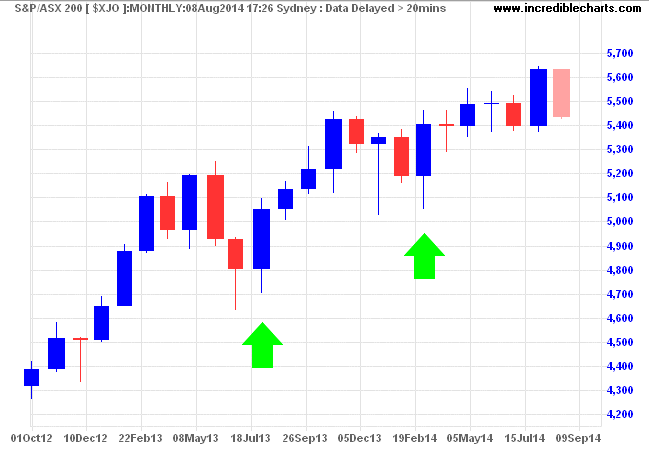
Attempt to time the correction and you may miss the best-performing months.
That's all from me for today. Take care.
Never interrupt your enemy when he is making a mistake.
~ Napoleon Bonaparte
Disclaimer
Research & Investment Pty Ltd is a Corporate Authorized Representative (AR Number 384 397) of Andika Pty Ltd which holds an Australian Financial Services Licence (AFSL 297069).
The information on this web site and in the newsletters is general in nature and does not consider your personal circumstances. Please contact your professional financial adviser for advice tailored to your needs.
Research & Investment Pty Ltd ("R&I") has made every effort to ensure the reliability of the views and recommendations expressed in the reports published on its websites and newsletters. Our research is based upon information known to us or which was obtained from sources which we believe to be reliable and accurate.
No guarantee as to the capital value of investments, nor future returns are made by R&I. Neither R&I nor its employees make any representation, warranty or guarantee that the information provided is complete, accurate, current or reliable.
You are under no obligation to use these services and should always compare financial services/products to find one which best meets your personal objectives, financial situation or needs.
To the extent permitted by law, R&I and its employees, agents and authorised representatives exclude all liability for any loss or damage (including indirect, special or consequential loss or damage) arising from the use of, or reliance on, any information. If the law prohibits the exclusion of such liability, such liability shall be limited, to the extent permitted by law, to the resupply of the said information or the cost of the said resupply.
Important Warning About Simulated Results
Research & Investment (R&I) specialise in developing, testing and researching investment strategies and systems. Within the R&I web site and newsletters, you will find information about investment strategies and their performance. It is important that you understand that results from R&I research are simulated and not actual results.
No representation is made that any investor will or is likely to achieve profits or losses similar to those shown.
Simulated performance results are generally prepared with the benefit of hindsight and do not involve financial risk. No modeling can completely account for the impact of financial risk in actual investment. Account size, brokerage and slippage may also diverge from simulated results. Numerous other factors related to the markets in general or to the implementation of any specific investment system cannot be fully accounted for in the preparation of simulated performance results and may adversely affect actual investment results.
To the extent permitted by law, R&I and its employees, agents and authorised representatives exclude all liability for any loss or damage (including indirect, special or consequential loss or damage) arising from the use of, or reliance on, any information offered by R&I whether or not caused by any negligent act or omission.

Author: Colin Twiggs is a former investment banker with almost 40 years of experience in financial markets. He co-founded Incredible Charts and writes the popular Trading Diary and Patient Investor newsletters.
Using a top-down approach, Colin identifies key macro trends in the global economy before evaluating selected opportunities using a combination of fundamental and technical analysis.
Focusing on interest rates and financial market liquidity as primary drivers of the economic cycle, he warned of the 2008/2009 and 2020 bear markets well ahead of actual events.
He founded PVT Capital (AFSL No. 546090) in May 2023, which offers investment strategy and advice to wholesale clients.
